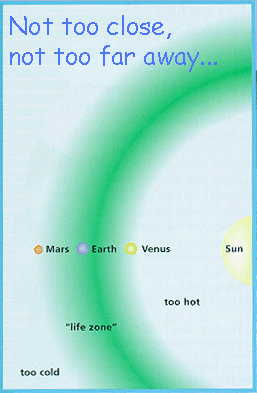![]()
You can often hear astronomers talk about the "life zone" or the "green zone" -- especially now that we are detecting planets around other stars. These terms are used to describe the distance region around a star in which a planet would have a moderate enough temperature range to allow for life to flourish. On Earth, for example, many living things have developed because we get just the right amount of heat and light from the Sun. Most of the surface of the Earth is neither too hot nor too cold. Moderate temperatures allow for liquid water, an ingredient essential to the development of life as we know it. If Earth was much closer to the Sun, it would be too hot and the water would boil away. If it was much further away, water would freeze into ice. In other words, you can think of the life zone as the distance region around the Sun (or any star) at which a planet is likely to have a stable supply of liquid water. In our solar system, only Earth lies within the green zone. Venus and Mars lie at the very inner edge and outer edge, respectively, of the zone. There is ample evidence that both of those planets had liquid water on their surfaces in the past, but show none there now.

![]()
The StarChild site is a service of the High Energy Astrophysics Science Archive Research Center (HEASARC), within the Astrophysics Science Division (ASD) at NASA/ GSFC.
StarChild Authors: The StarChild Team
StarChild Graphics & Music: Acknowledgments
StarChild Project Leader: Dr. Laura A.
Whitlock
Curator:
Responsible NASA Official: